We have a classic opportunity for education and leadership, not stalling and cowardice. How much more trauma, injury, death and lost potential will we endure while we wait to act?
By Ryan McGreal
Published September 09, 2014
Can anyone today stand up with a straight face and still claim that Hamilton's network of paired one-way thoroughfares constitutes some kind of "competitive advantage" for the city? Property developers certainly don't think so.
The Spectator's Paul Wilson writes that the family behind the redevelopment of 401 Richmond and the Gladstone Hotel in Toronto have bought the old Imperial Cotton factory at 270 Sherman Avenue North.
There's plenty to be excited about with that news, but note the closing comment by developer Rob Zeidler:
He does have one beef about Hamilton - one-way streets. "Two-way brings people, stores, makes a neighbourhood," he says. "I'll be fighting for that here on Sherman."
The way we have done other conversions in the past several years, I would not be surprised if the City assents to his wishes by converting Sherman to two-way between Biggar Avenue and Landsdowne Street.
When Vrancor built the Staybridge hotel at Caroline and George and began work on the Homewood Suites on the block framed by Caroline, George, Bay and Main, the company requested that Caroline be converted to two-way south of Main so that people can access the buildings more easily.
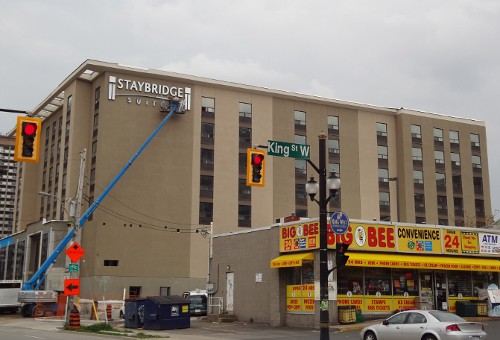
Sign going up on Staybridge Suites Hotel (RTH file photo)
The City converted exactly two blocks of Caroline to two-way, between Main and King Street. There are two lanes in the original southbound direction and one reluctant lane northbound.
The Downtown Transportation Master Plan includes two-way conversion of Caroline all the way to York Boulevard, but the reconfiguration of the Caroline/York intersection has not been budgeted.
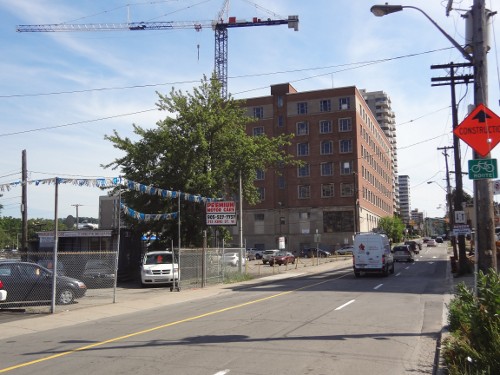
'Two-way in name only' on Caroline (RTH file photo)
Likewise, the redevelopment of the old Studebaker factory site into a new industrial park hinges on the two-way conversion of Victoria Avenue North.
Old Studebaker Plant (Image Credit: Wikimedia Commons)
A Spectator article from April 2014 cites project manager Sergio Manchia:
He said there is a solid market demand for this kind of product, simply because there isn't much available, particularly in the city's core.
But after two years of jumping regulatory hurdles with at least another year ahead, Manchia said he understands why industrial spaces are rarely redeveloped. Just one of those hurdles is getting final council approval for a proposal to turn Victoria Avenue into a two-way street that would facilitate ingress and egress into the site.
The City plans to convert Victoria to two-way between Burlington and Barton Street.
Victoria currently functions as an extension of the northbound side of the expressway-like Claremont Access, with Wellington as the southbound side.
Both streets are grotesquely overbuilt monstrosities that traumatize their neighbourhoods to carry a relative trickle of cars, making them dangerous and unwelcome for pedestrians and cyclists and seriously harming livability for local residents and businesses.
Wellington at Wilson carries just 12,200 cars a day on four one-way lanes - more than double the necessary capacity for that volume of traffic.
Victoria North carries a paltry 8,900 cars a day at Barton on its four one-way lanes - literally four times the necessary capacity for that volume.
We can keep going. Sherman carries 9,900 cars a day at Cannon on its four lanes. Wentworth carries a pathetic 5,400 cars north of King on its three one-way lanes.

Wellington Street North during afternoon rush hour (RTH file photo)

Sanford Avenue does not need to be a one-way thoroughfare

At Sanford and King, they had to put up steel bollards to protect the sidewalk

Wentworth Street does not need to be a one-way thoroughfare

Birch Avenue is a ridiculously unnecessary highway
This is insanity made manifest.
A predictable result of insanely overbuilt streets that have been engineered for 70-100 km/h vehicle speeds is that people drive at homicidal speeds through vulnerable urban neighbourhoods.
Last night, a collision on four-lane, one-way Wilson Street near Steven Street was so severe that one car ended up on a front lawn and the other ended up lying upside-down in a wide spray of debris.
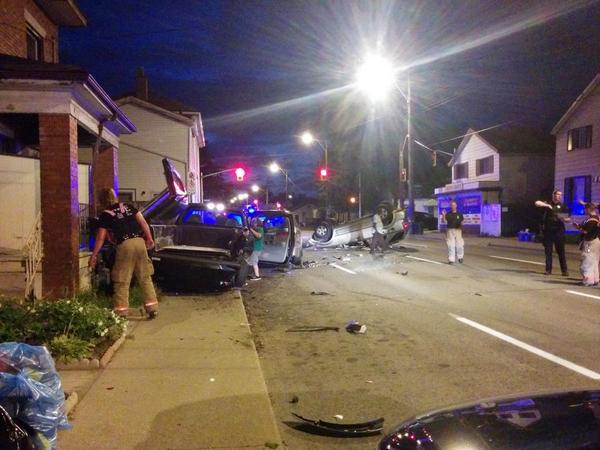
Collision on Wilson Street near Steven (Image Credit: Joey Coleman)
York Boulevard/Wilson Street was converted to two-way between between Bay and Ferguson in December 2010, and then Wilson was converted to two-way between Ferguson and Victoria in July 2011. Beyond Ferguson, it's still four mostly-empty one-way lanes.
This kind of freeway-style collision shouldn't be physically possible on a city street. But it's far from unprecedented for an area of the city where most arterials still look like freeways more than a decade after Council voted to convert many of them back to two-way.
In July, a single-vehicle collision on Main near Victoria obliterated a bus shelter and left the car a crumpled mess.
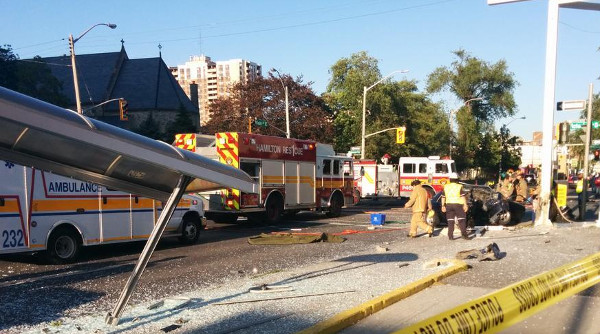
Scene of the July 5, 2014 crash on Main near Victoria (Image Credit: Joey Coleman)
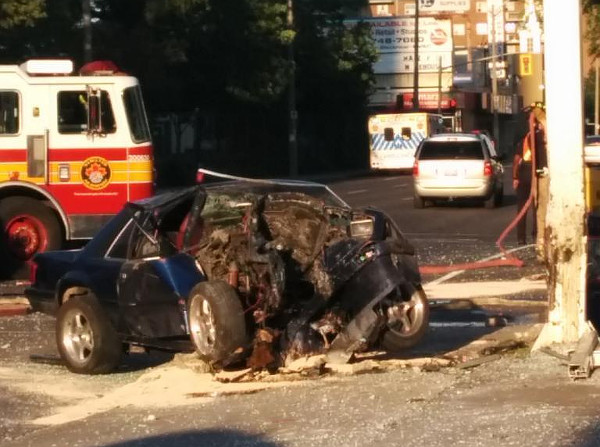
Smashed car after July 5, 2014 collision (Image Credit: Joey Coleman)
Earlier this year, two middle-aged male drivers were charged with stunt driving and speeding when they were clocked going 125 km/h on the aforementioned Claremont Access.
Council has been extremely reluctant to act on the two-way conversions it approved all the way back in 2001, and when staff bring forward conversion proposals at all, they are tepid plans that convert just a couple of blocks at a time.
Amazingly, a CAA South Central Ontario survey on two-way conversions undertaken in the end of 2012 found that a clear majority of Hamiltonians already support the conversion of secondary north/south streets and a plurality of Hamiltonians support converting downtown side streets.
The only conversions that a majority of respondents opposed were the major east-west streets (Main/King/Cannon). Even there, support was stronger with younger residents.
The summary report noted: "The majority of reasons for not supporting changes are emotional, not safety or financially founded."
This is a classic opportunity for education and leadership, not stalling and cowardice. How much more trauma, injury, death and lost potential will we endure while we wait to act?
By anti-one-way (anonymous) | Posted September 09, 2014 at 16:00:51
Having lived on one of the streets between Sherman and Birch at Barton - I can tell you that they both function as two ways - if you don't mind the detour onto Princess... clocked a transport truck doing 70km/h on Earl Street between Barton and Princess. Check a map for the insanity of that.
By CharlesBall (registered) | Posted September 09, 2014 at 16:27:54
Is there anyone alive today other than me who remembers the chaos on our major arteries when they were two way and bottled up with the street cars relying on overhead wires that disconnected frequently backing up everyone? Do they remember being significantly opposed to the one way street plans and then changing their minds when, overall, it significantly improved traffic congestion in the City and significantly reduced the amount of time spent in transit both public and private? Do they remember bragging to their friends in other cities, particularly Toronto, about how the one way streets vastly improved their lives? Do they remember the planners telling developers who would have been like Vancor, to relax and to wait and see and not to wine about their particular street as overall everyone would benefit? Is there anyone who realizes that the reduction in Hamilton's traffic is a symptom and not a cause of decay largely based on the shift in world economics having nothing at all to do with one way or two way streets, but giving us all the benefit of reduced traffic flow and saving us time and energy? Is there anyone here who acknowledges that overall traffic safety is far superior today than at any time in history per capita or otherwise? Is there anyone fearful that plugging up our roadways will create a reduction in safety, an increase in frustration and cost with no proven benefits?
Comment edited by CharlesBall on 2014-09-09 16:30:21
By Dreadwing (anonymous) | Posted September 11, 2014 at 01:45:49 in reply to Comment 104390
"Is there anyone alive today other than me who remembers the chaos on our major arteries when they were two way and bottled up with the street cars relying on overhead wires that disconnected frequently backing up everyone?"
Well, since the streetcars were retired in 1951, and the fact that you can remember traffic problems caused by a dewireing, then that would likely make you older than 70. So the answer is a lot closer to 'No' than to 'Yes'
By YHMDesigns (registered) - website | Posted September 09, 2014 at 18:17:38 in reply to Comment 104390
Charles, I will respectfully suggest that was then and this is now. This is not a one-variable equation (i.e. your implication that one-way streets have played a significant role in improving traffic safety). Is Toronto inherently unsafer than the lower city? Heck, is the Mountain inherently unsafer than the lower city? I don't remember a drive along Upper James to be fraught with peril.
Also, if congestion were that much of a dissuasion, people would be fleeing Toronto (or London, or Hong Kong) rather than continuing to squeeze in. Clearly, the opportunity (in their minds) outweighs the inconvenience. If Hamilton becomes more prosperous at the expense of additional traffic congestion, then folks will deal with it.
Hamilton has many one-way streets configured for a time long past. Yes, the economy has changed, but suggesting that keeping the streets one-way will stimulate growth (or at least reduce decay) doesn't fly. Perhaps the one-way streets are a causal factor in the economic decline and that's the wrong to be righted.
Also, while this excess capacity is sweet from a driver's perspective, it comes at the expense of pedestrian and cyclist safety as well as liveable streets. If you're going to stake the moral high ground and ask us to put safety first, then you have to take all these factors into consideration -- otherwise your argument is specious.
And this excess capacity isn't free. Hamiltonians are paying for it in care and maintenance. If shown the bill, I would think minds would start to change.
All you've given us Charles are youthful anecdotes about trolley-incited "chaos", a blanket suggestion that one-way streets are key driver of road safety, and an apocalyptic vision of interminable bottlenecks. Not good enough.
Of course switching a large portion of the grid back to two-way will bring its compromises, but let's discuss it in an informed and rational way. On the subject of fear, I am fearful we will side with the automobile and place ourselves on the wrong side of history.
By Safety (anonymous) | Posted September 09, 2014 at 22:22:18 in reply to Comment 104396
In Mr. Ball's defence, it was Ryan who said "How much more trauma, injury, death and lost potential will we endure while we wait to act?" Which implies that one way streets impose the trauma, injury and death. I don't think Mr. Ball raised the safety issue. (I usually post under another name but am not at my computer and I hate one way streets.)
By YHMDesigns (registered) - website | Posted September 10, 2014 at 09:03:23 in reply to Comment 104401
Point taken. Charles, you were addressing a point Ryan had raised.
Yes, road safety has improved significantly over the years and cannot be discounted. However, those figures are averages of averages. You will find some areas or conditions safer than others. Where there is a deficiency, then you work to close the gap.
For instance, I support higher speed limits (i.e. 120 km/h) on the 400-series highways. I have read there is data to support the argument.
However, I believe the general thesis in this discussion is that streets designed as part of the urban grid that have become used as virtual highways cause harm that could be rectified with certain measures. Tailoring traffic flow to suit their original design seems reasonable to me, especially given current and anticipated volumes.
I don't think it's wise to accept the idea that things are "safe enough".
By Pxtl (registered) - website | Posted September 09, 2014 at 17:41:08 in reply to Comment 104390
I can understand people who defend major arteries like Main, King and Cannon in their one-way form. Those ones at least provide some measurable value in exchange for the problems they cause. I can't understand wanting residential side-streets like Sherman to stay 1-way. Have these roads ever had enough congestion to demand 1-way traffic? Ever?
By jason (registered) | Posted September 09, 2014 at 22:01:23 in reply to Comment 104395
I'm not sure about any 'value in exchange'. Main and King are horrendous. And for over a century they were the economic heartbeat of downtown Hamilton along with east and west end neighbourhoods. Now just barren freeways that carry a fraction of the traffic they were built for.
I could see the argument for them if they carried 40-50,000 cars a day, but they don't.
Main in front of city hall carries enough traffic to be handled by 2 lanes with a turning lane. East of Wellington it carries the same traffic as the Queen St Hill, which is 1-lane each way. We have 5 lanes one-way.
I would like to see Main either go two way with parking on one-side, or have 2 lanes removed and replaced with a parking-protected two-way cycle track from Longwood to the Delta.
By RobF (registered) | Posted September 10, 2014 at 22:04:03 in reply to Comment 104400
I would like to see Main either go two way with parking on one-side, or have 2 lanes removed and replaced with a parking-protected two-way cycle track from Longwood to the Delta.
I agree, but do you have a preference?
For most streets i favor two-way, but the new Cannon configuration has me rethinking whether a few scaled-down east-west one-ways with two-way cycle-tracks and better design could be an acceptable medium-term outcome ... not ideal, but a major improvement that should be easier to sell now that Cannon exists.
For North-South one-ways i can't see what the hold up is with conversion other than money and manpower. Are there really planners or public works people at City Hall that think the status quo is worth preserving? I live near Wellington and I can't see for the life of me how two-way wouldn't be an improvement for all concerned. The same would apply to Sherman and Wentworth, etc.
Comment edited by RobF on 2014-09-10 22:38:19
By Pxtl (registered) - website | Posted September 11, 2014 at 10:31:01 in reply to Comment 104421
Personally, my ideal configuration would be full Complete Street treatment with 2-way and bike lanes on King east of Queen (and TWINO from Queen to Dundurn), 1-way + LRT on Main, and Cannon stays as-is with the addition of North-side parking.
Then there's a 2-lane 1-way synced-light corridor in each direction across the city (Cannon/Queen/King westbound, Main eastbound) a complete downtown King Street for all modes of slower traffic, an LRT on Main, and the Cannon cycle track. Something for everyone.
Then get rid of the 1, 5-9 buses and rebuild them as local short-loop routes that rendezvous with their nearest LRT stops instead of going downtown. And run a second LRT down the Clairmont Access to the Hamilton General and then alongside the existing rail lines to the James North station, with a nice transfer platform built at Main at Victoria.
But of course, we've already planned the B-line on King, so I'll take that in a pinch.
By RobF (registered) | Posted September 11, 2014 at 11:42:48 in reply to Comment 104432
The LRT is really the straw that stirs the drink. Your ideal configuration makes a lot of sense, but given LRT is planned to go down King it is hard to imagine it switching to Main. Plus, I assume the planners put some thought into putting it on King rather than Main. Although, plans can change at a certain stage path dependency kicks in.
By jason (registered) | Posted September 11, 2014 at 21:13:25 in reply to Comment 104435
I guess if I had to think of the collection of E/W main roads being discussed here, my top pref would look something like this: King St: 1-lane each way, curb parking on both curbs (perhaps some 7-9 restrictions heading into downtown and 4-6 leaving downtown in the eve).
Cannon: the new cross-section east of Victoria extended to Hess: 24-7 parking on north side, 2 traffic lanes, protected bike lanes. Alternately, both car lanes could become 1 each way with necessary turning lanes at intersections being accommodated by losing a few parking spots approaching the intersection.
Main: north curb lane converted to protected 2-way cycle track. 2-way LRT in the next two lanes. 2 eastbound car lanes.
And yes, all the N/S streets can become two-way tomorrow. But I'd worry that the city won't calm them appropriately. They'll try to accommodate 2-lanes each way like we did on Wilson. Wellington/Victoria etc. can, and should become neighbourhood arterials with 24-7 parking, 1-lane each direction and protected 2-way bike lanes.
By RobF (registered) | Posted September 12, 2014 at 12:44:31 in reply to Comment 104465
Not a bad setup. I see you too would put the LRT on Main. I've only been here since 2011, so most the LRT planning and design predates me. What was the rationale for the planned configuration? Is it mainly to enhance street retail on King and because Jackson Square is on King?
I haven't thought much about the design of the N/S streets after conversion. How does the city decide on configuration? Are they open about their design process and rationale?
Comment edited by RobF on 2014-09-12 12:44:58
By Cynicus (anonymous) | Posted September 09, 2014 at 17:10:08 in reply to Comment 104390
@CharlesBall is, evidently, a fan of having highways right through the middle of residential neighbourhoods; highways that make horrible activities like walking, biking, playing outside, or (most vile of all) breathing into treacherous, taking-your-life-in-your-hands activities. His version of the history of "overall traffic safety" only encompasses the history of the privately-owned automobile, as does his assessment of benefits and costs. Rest assured Mr. Ball, nothing could more improve my safety and reduce my frustration than slowing down, diverting, or eliminating the murder-machines from our streets.
By Anon (anonymous) | Posted September 09, 2014 at 16:33:07 in reply to Comment 104390
So the city of 2014 resembles the city of 1956 in your mind's eye? There are no new streets/roads; mountain accesses, etc? Apples to apples?
By jason (registered) | Posted September 09, 2014 at 19:08:12
So everyone who comes here and wants to invest millions has the same request from city hall? Maybe someone should tell Lloyd Ferguson. They are coming here in spite of our one-way freeways, not because of them.
The one-way network was done due to the crazy traffic volumes heading the industrial quarter. 80,000 jobs once existed down there. Now there's a few thousand.
And I'm no genius, but we no longer have streetcars with old-style wires falling off blocking traffic.
By uncle lloyd (anonymous) | Posted September 10, 2014 at 11:05:18
But uncle lloyd--Dufferin cement business lloyd, though an observant friend says lloyd didn't put that on the record, just for the record, when he was pushing for cement covered city hall, that Lloyd--him screaming now for all Ancaster to be one way streets, probably: ''give me one ways on the west mtn or give me defeat''--he's probably screaming. right?
You must be logged in to comment.
There are no upcoming events right now.
Why not post one?